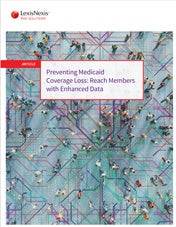Preventing Medicaid Coverage Loss
Taking the Pulse on the Public Health Emergency Unwinding Process
Growing Concerns about Unwinding Outcomes
and Ways to Help
The Public Health Emergency Medicaid Unwinding process that began in April of 2023 is underway, and analysis of state reporting reveals data challenges are interfering with keeping eligible Medicaid members covered. State and federal officials want to ensure that eligible Medicaid beneficiaries maintain coverage as renewals are processed for the first time in three years. The Centers for Medicare and Medicaid Services (CMS) set a goal that no eligible Medicaid members would lose coverage during the unwinding process.
The most recent State data shows Medicaid programs across the country are struggling to meet that goal, with a large part due to incomplete and/or inaccurate Medicaid member data. State Medicaid programs were given fourteen months to process renewals and disenroll Medicaid members who are no longer eligible or who do not complete redetermination processes. Before disenrolling a Medicaid member, states must complete an “ex parte” or automatic renewal process to determine eligibility. In an ex parte renewal, states check available sources of data on wages and benefits to determine a Medicaid member’s eligibility. As of December 18, 2023, more than 13.3 million Medicaid members have been disenrolled from coverage, according to a Medicaid enrollment and unwinding tracker published by the Kaiser Family Foundation (KFF).1
KFF’s analysis further reveals that, “across all states with available data, 71% of all people disenrolled had their coverage terminated for procedural reasons.”1
Procedural disenrollments occur when states cannot verify an individual’s eligibility. This happens when a state does not have updated contact information or does not receive a completed renewal packet within the required time frame. Medicaid members who lose coverage due to procedural disenrollments may still be eligible, leading to a loss of coverage for populations who still qualify.
Growing Concerns about Unwinding Outcomes
Widespread disenrollments are a significant risk to state Medicaid programs and will have a large impact on the health and well-being of Medicaid beneficiaries.
- States will lose Medicaid funding for residents who are still eligible.
- Renewal notices, sent for the first time in at least three years, may be hard to understand for Medicaid members unfamiliar with the process.
- Required eligibility documents may be difficult to find or send in. Individuals may think they’re still covered, even when they’ve been disenrolled.
- Parents who are no longer eligible for Medicaid may not realize their children are still eligible.
- Access to care will be interrupted, and providers and managed care organizations could lose contact with individuals with ongoing health needs.
As part of its unwinding guidance, CMS has offered multiple flexibilities for states seeking to prevent or mitigate enrollment disruptions for Medicaid-eligible individuals and urges continued adoption of these flexibilities.
Opportunities to Address Data Challenges and Improve Unwinding Outcomes
How can these findings inform state strategies before it’s too late and unintended consequences are irreversible? State Medicaid programs need better, more comprehensive data to effectively process renewals and reduce coverage gaps for eligible beneficiaries. Limited resources within state agencies and inaccurate data are barriers to effective unwinding processes.
Bottom Line: State Medicaid Strategies Need Better Contact Data and Asset Verification to Ensure Minimal Disruption to Coverage As state Medicaid programs undertake a comprehensive process to redetermine eligibility for every Medicaid beneficiary in their programs, initial results reveal incomplete or inaccurate contact information causing thousands of individuals to lose coverage — even when they still may be eligible for Medicaid. Even with the best outreach efforts, Medicaid organizations may fall short of having the most up-to-date contact data to connect their population to appropriate resources.
LexisNexis® Risk Solutions can provide access to current and critical contact information for hard-to-reach Medicaid beneficiaries. Armed with 90 billion public records from more than 10,000 different sources, the LexisNexis® AmplifyID™ for Unwinding solution helps agencies quickly gain access the most updated contact information to contact Medicaid beneficiaries with speed and precision. As states encounter bumps in their approach, we are here to help. We provide customized, scalable solutions designed around a state Medicaid agency’s specific needs and population.
1. https://www.kff.org/report-section/medicaid-enrollment-and-unwinding-tracker-overview/Products You May Be Interested In
-
AmplifyID™ Master Person Index
Ensure equitable access and smooth service delivery with a precise, whole-person view
Discover More -
AmplifyID™ Identity Risk Navigator
Get a clear view of your program’s participants to pinpoint fraudsters and stop improper payments.
Discover More -
Social Determinants of Health
Social Determinants of Health (SDOH) fuel insights into health risks and the ability to proactively impact health outcomes for veterans, military and others.
Discover More -
Provider Integrity Scan
Know your providers, reduce risk, and prevent fraud.
Discover More -
Multi-Factor Authentication for Healthcare
Authenticate members and providers
Discover More -
Instant Age Verify
Verify identities and ages
Discover More


